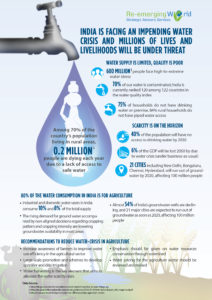How do we get out of the impending water crisis leading to food insecurity in India

More than 80% of water consumption in India is for agriculture whereas the industrial sector uses less than 5% water. However, most surprisingly, unlike an industrial sector, there is no firm water conservation policy in action in agriculture. Little or no practice of conserving groundwater, abundant use of inefficient irrigation, corruption in water management and development of irrigation projects are the causes of fundamentally agriculture-led water crisis faced by 600 million people in India.
In its Composite Water Management Index Report in June 2018, NITI Aayog has warned us about the worst water shortage scenario in India. Populous agricultural states like Uttar Pradesh, Jharkhand, Bihar, and Haryana who are home to a bulk of country’s farm output are significantly low performers in water index ranking. By 2020, NITI Aayog report predicts that at least 21 Indian cities will run out of the water and neglected water management would lead us to severe food insecurity as well as a 6% drop in GDP by 2050. However, several water-scarce states are leaders in the water management performance and about 60% of the states included in the index have improved their score in Financial Year 2016-2017.[1]
Total 1034 out of 6584 assessed blocks in the country were labeled ‘dark zone’ as annual groundwater consumption in these blocks is more than the annual groundwater recharge. However, the World Bank has approved India’s Rs. 60 billion central scheme that aims to improve groundwater management in priority areas in the country through community participation over 2018-2023.[2]
Out of 4000 billion cubic meters (BCM) of sweet water in the country, only 1123 BCM is usable of which groundwater supplies 395 BCM.[3] The rising demand for groundwater accompanied by non-aligned decisions regarding cropping pattern and cropping intensity are lowering groundwater availability in most areas. The principal means of irrigation in the country are canals, tanks, and wells, including tube-wells. Of all these sources, groundwater constitutes the most significant share. Wells, including dug wells, shallow tube-wells, and deep tube wells provide about 61.6% of water for irrigation, followed by canals with 24.5%. India uses nearly twice the amount of water to grow crops as compared to China and the United States. Evaporation, transpiration, and run-off of water from inefficiently irrigated land comprise a handsome amount of groundwater wasted. The government of India has acknowledged the need for, and the potential benefits for drip irrigation and hence is extending the subsidy for drip irrigation through special programs like National Mission on Micro-irrigation.[4] If well-implemented, crop productivity would increase bringing more income to the farmers. Accordingly, there will be significant savings of resources like water and energy.
However, although sprinkler and drip- both are methods of micro-irrigation (MI), they are different from each other regarding the process and potential. While the drip method of irrigation (DMI) is highly suitable for widespread horticulture and other crops, sprinkler method of irrigation (SMI) can be used effectively for cereals and millets. A detailed estimate of the state-wise potential for DMI and SMI would be useful to fix the target of crop productivity and water efficiency. Along with that, farmers should be encouraged more to use water from surface sources for MI.[5]
There should be more studies to find out the feasibility of low-cost drip materials including its water feasibility using field-level data MI manufacturers need to involve intensively in promoting MI by introducing frequent demonstration at farmer’s fields. Also, training facilities for farmers are essential to increase the adoption of MI.
The rate of subsidy provided by the government through different schemes is fixed uniformly for both water-intensive as well as less water-intensive crops. There should be a restructured subsidy scheme. Often, extensive and expensive water management and irrigation system help water corruption in procurement easy and profitable. Big agricultural business can pay bribes for access to irrigation. Corrupted officials sometimes over-invoice the maintenance contracts. Also, bribery means that the water pollution often goes unpunished thus leading to a decrease in usable water. Renowned water conservationist Rajendra Singh explicitly claims that transparency in irrigation projects and water literacy campaign are the need of the hour to end the water crisis in India.
India shares 18% of world’s population but only 4% of the total water resource. National Water Policy, formulated by the Ministry of Water Resources of the Government of India, administers the planning and development of water resources and their optimum utilization. Smart and sustainable use of water can help terminate the water crisis of ever-increasing population in India shortly. Considering the ecological needs of rivers, India has been doing well in creating live water storage capacity of about 253 BCM so far primarily by linking the rivers. However, regarded as Waterman of India, Rajendra Singh states that, “We have to blame ourselves. We changed the course of rivers. We built dams indiscriminately. Moreover, there is a climate change. We could solve the looming crisis if local and traditional solutions were followed.”
#NITI_Aayog_Composite_Water_management_Index_report
#Water_Crisis_Leading_to_Food_Insecurity #Micro_Irrigation_for_Water_Conservation
#Water_Use_in_Agriculture











